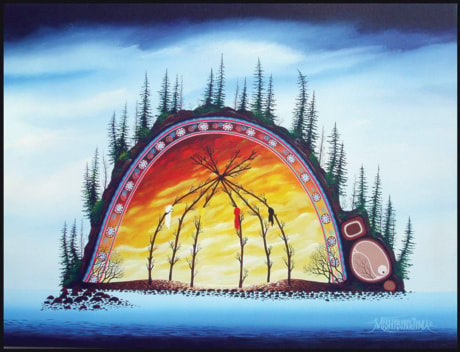VANCOUVER — The seven children of acclaimed aboriginal artist Norval Morrisseau have filed a lawsuit in B.C. Supreme Court to challenge the validity of their late father’s will.
Morrisseau, who once hailed as “the Picasso of the North,” died at age 75 in Toronto in December 2007.
His children say his will, dated July 16, 1999, was executed under suspicious circumstances.
In their lawsuit filed Wednesday, Morrisseau’s adult kids say that at the time, their father was suffering from Parkinson’s disease and wasn’t capable of approving the will’s contents.
The will names Gabor Michael Vadas, Morrisseau’s business manager, as the sole beneficiary.
Morrisseau’s children say they also want control over the right to use their father’s name and images to reproduce his unique works, many of which are featured in Canada’s most prestigious galleries.
“We want to honour dad’s legacy as one of the greatest Canadian and aboriginal artists,” said his daughter Victoria Morrisseau Kakekagumick, who lives in a remote fly-in reserve in Keewaywin, Ont., along with four of her siblings.
“I believe dad wanted his estate to stay in the family,” she said. “I know he wouldn’t disinherit us on purpose.”
One of Morrisseau’s children lives in Toronto while another lives in Thunder Bay, Ont., said Ted Charney, one of the family’s two lawyers.
Charney said Morrisseau’s children have also filed court documents to prevent Vadas from probating the will without being challenged by them.
“What’s alleged in (Wednesday’s) claim is that he was unduly influenced into signing the will and part of the undue influence is that he wasn’t physically or mentally capable of making that kind of decision at that time,” he said from Toronto.
Charney said Morrisseau’s children want to hear from people who would have known their dad in the late 1990s when he was living in Vancouver and Nanaimo, B.C., where he spent several years in a nursing home before going to Toronto, where he died.
“We’re hoping to hear from people about what his health was like and his relationship with Mr. Vadas,” Charney said.
He said Morrisseau’s family and Vadas were engaged in a dispute after the artist died because they wanted him buried next to their mother on the Keewaywin reserve while Vadas insisted on having his remains cremated.
The family ultimately won out, and Morrisseau’s final resting place is next to Harriet Morrisseau, from whom he was divorced after 18 years of marriage, Charney said.
Morrisseau, an Ojibwa from the Red Rock band in Nipigon, Ont., was a self-taught artist whose vibrant paintings and birchbark drawings were adored around the world.
His works depicted animals and spiritual creatures and he pioneered what became known as the Woodland school of painting, which featured aboriginal photographs.
